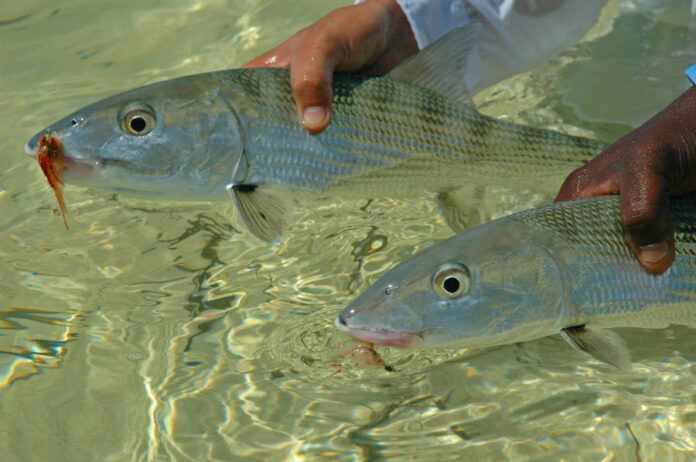Written by: Greg Vincent, H2O Bonefishing
Knowing when to set the hook is a vital skill that will help you land more bonefish.
Photo courtesy H20 Bonefishing
When some anglers and experts talk about the requirements for successful bonefishing, there is an over-emphasis on casting and too little attention paid to proper hook-setting technique. Of course, you should practice casting, but don’t get too caught up in perfecting the more visually pleasing aspects of your cast, such as making lovely tight loops. Some of the best saltwater-flats anglers I know are not the prettiest casters, but they know exactly what to do once that fly touches down. Bonefish don’t consider the tightness of one’s loops before deciding to eat. So assuming that you have delivered the fly and now have a bonefish zeroing in on it, what should be going through your mind?

Casting is an important part of bonefishing, but it isn’t everything.
The first thing to know, of course, is that you must set the hook with a strip—No trout sets!—but that’s not everything you need to consider at the moment that bonefish reaches your fly. A strip-strike is what you need to do, but equally important to success is when you do it. Conventional wisdom says that you should strike “when you feel the fish,” and this is often good advice. I would argue, however, that if you only set when you feel the fish, you will miss as many bonefish—if not more—than you will hook. Remember that, when you are fishing from a boat, you often have to contend with slack between you and the fly. The dreaded bane of all things flats fishing, slack will delay your ability to feel the bonefish take. Therefore, anglers need to develop reactions based on the visual indicators first and rely on feel as a secondary bite indicator.

Sight-fishing in shallow water gives the angler an advantage that he or she should take advantage of.
Here’s how this works in a real-life flats-fishing situation:
You’ve made the cast, and a bonefish charges your fly. As it gets to the fly, the fish stops. There are only two reasons why a bonefish charges your fly and suddenly stops: it has eaten your fly or it has refused your fly. As soon as the fish stops, set the hook!
If you set the hook as soon as the fish stops—whether you feel it or not—then you will hook two or three times as many bonefish as you would if you always wait to feel the fish. Not only will you hook the fish that ate the fly, but you’ll also increase your chances of hooking the fish that refused your fly. Your long strip strike to set the hook will reanimate the fly, which may induce that bonefish to take. Therefore there is no downside to setting the hook when the fish stops.
So, especially when you’re fishing from a flats skiff, always set the hook when you see a fish stop at your fly. Using your eyes works better than only using your fingers to detect strikes, and that is what should be going through your mind at the moment of truth.
Greg Vincent is a co-owner of H2O Bonefishing on Grand Bahama Island.

You might not get a lot of shots at bonefish, so you need to make the most of each one.
Credit: Source link































